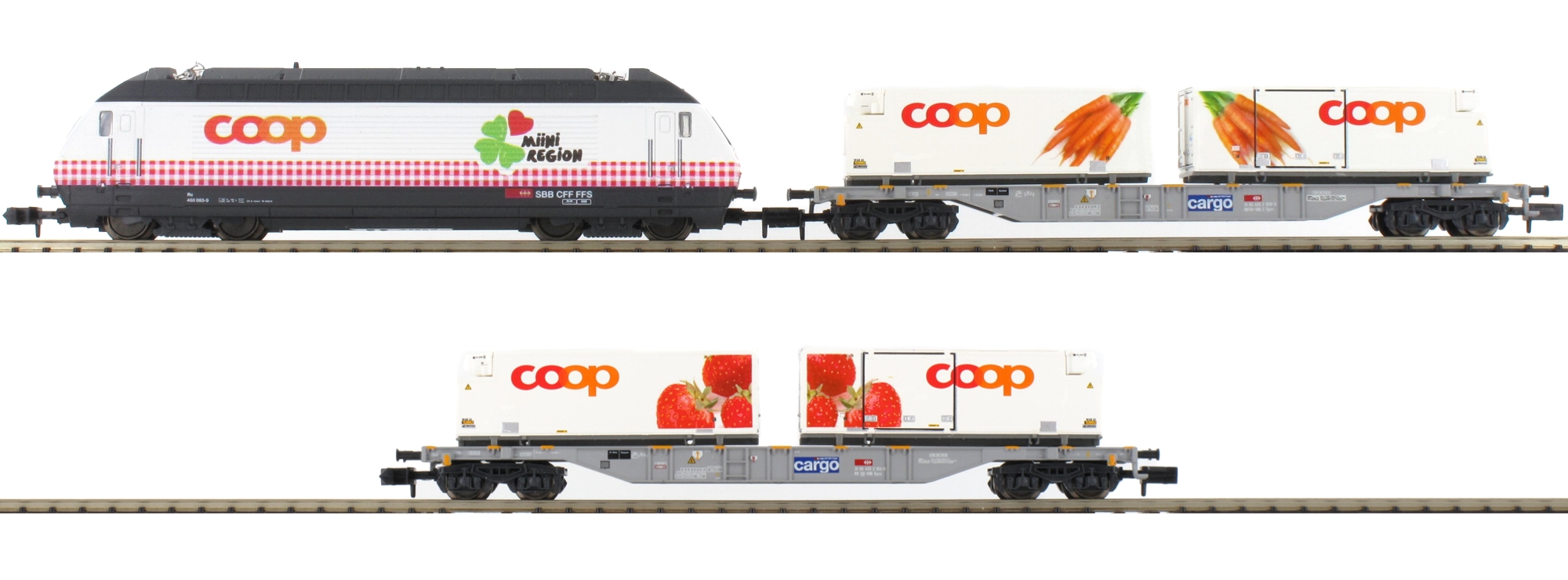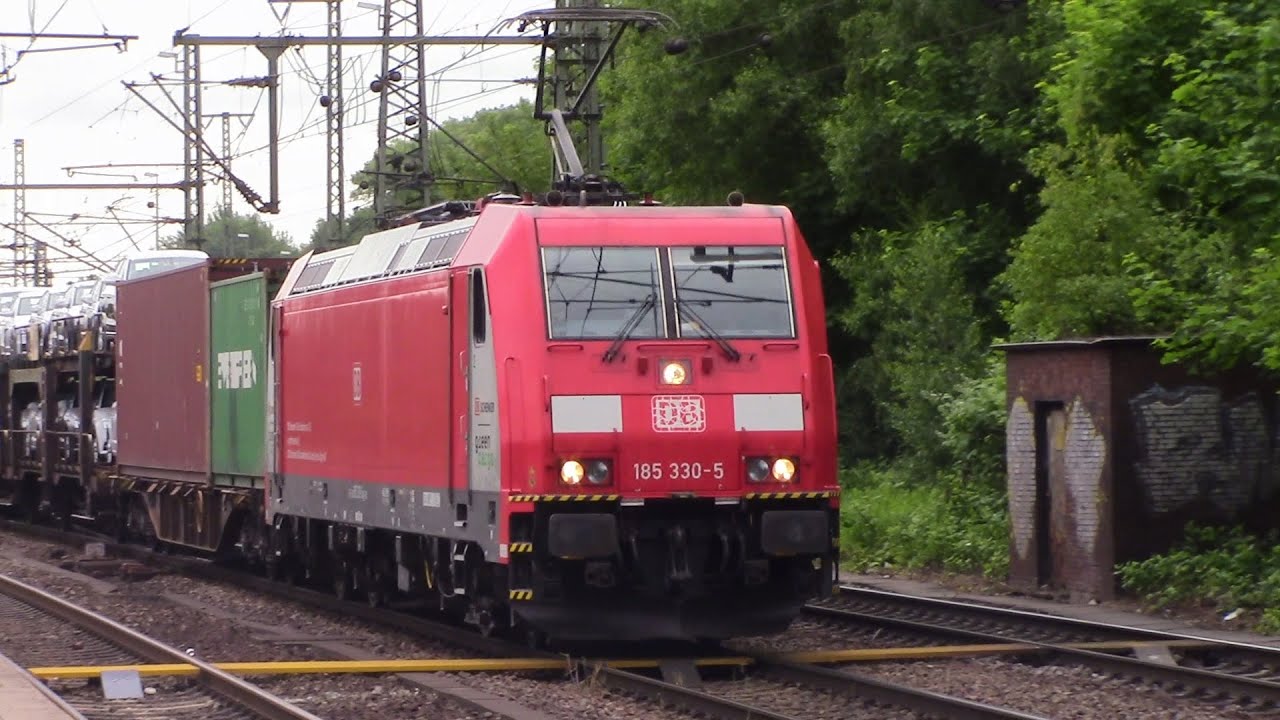Specific Item Information: Vorbild: Schnelle Mehrzwecklokomotive Serie Re 460 der Schweizerischen Bundesbahnen (SBB/CFF/FFS). Werbelokomotive des Schweizer Detailhändlers COOP. Lok-Betriebsnummer: 460 083-9. 2 Containertragwagen Sgns beladen mit Kühlcontainer der Firma COOP, eingestellt bei der Schweizerischen Bundesbahnen (SBB/CFF/FFS). Betriebszustand im Jahr 2015.
Modell: Eingebauter Digital-Decoder und Geräuschgenerator zum Betrieb mit DCC, Selectrix und Selectrix 2. Motor mit Schwungmasse, 4 Achsen angetrieben, Haftreifen. Stirnbeleuchtung und Schlusslichter mit der Fahrtrichtung wechselnd, mit warmweißen Leuchtdioden, Führerstandsbeleuchtung, digital schaltbar. Mit NEM-Kupplungsschacht. 2 Containertragwagen mit Kinematik für Kurzkupplung, beladen mit je 2 COOP-Kühlcontainer "Erdbeeren" und " Karotten". Gesamtlänge über Puffer 361 mm.
Modell: Eingebauter Digital-Decoder und Geräuschgenerator zum Betrieb mit DCC, Selectrix und Selectrix 2. Motor mit Schwungmasse, 4 Achsen angetrieben, Haftreifen. Stirnbeleuchtung und Schlusslichter mit der Fahrtrichtung wechselnd, mit warmweißen Leuchtdioden, Führerstandsbeleuchtung, digital schaltbar. Mit NEM-Kupplungsschacht. 2 Containertragwagen mit Kinematik für Kurzkupplung, beladen mit je 2 COOP-Kühlcontainer "Erdbeeren" und " Karotten". Gesamtlänge über Puffer 361 mm.
Prototype History: Epoch of liberalised railway traffic in Germany. New numbering system according to UIC or TSI (12-figure also for railcars), but no uniform design of livery.
Road Name History: Swiss Federal Railways (German: Schweizerische Bundesbahnen (SBB), French: Chemins de fer fédéraux suisses (CFF), Italian: Ferrovie federali svizzere (FFS)) is the national railway company of Switzerland. It is usually referred to by the initials of its German, French and Italian names, either concatenated as SBB CFF FFS, or used separately.
The company is headquartered in Bern.
Read more on Wikipedia.
The company is headquartered in Bern.
Read more on Wikipedia.
Brand/Importer Information: Trix is a German company that originally made Trix metal construction sets. one of its co-founders was Stephan Bing, the son of the pioneer toy-maker industrialist Ignaz Bing. In 1935 the company began producing the electrically powered model trains that it became famous for, under the Trix Express label. Prior to the outbreak of World War II the Trix company produced a small range of fairly unrealistic AC powered three rail models running at 14 volts.
N gauge models under the Minitrix brand were made from the late 1960s mostly of European prototypes (German and British primarily). North American prototypes were also manufactured and marketed under the Aurora "Postage Stamp" brand; later these items were sold under the American Tortoise, Model Power and Con-Cor brands. Trix sometimes utilized North American consultants to aid in the design of this portion of the product line. The "Hornby Minitrix' brand was used in the 1980s for a short lived range of British outline models using the earlier product tooling.
Trix's owner in the 1980s and 1990s was Mangold, which went bankrupt in the late 1990s and Märklin purchased the assets in January 1997. In part, this purchase was a reflection of Märklin's need for added production capacity; Trix had been manufacturing certain items for Märklin in previous years. The purchase was also in response to the earlier purchase of the Karl Arnold company by the Italian company Rivarossi; Märklin were very keen to take over Trix market share in 2-rail H0 and especially Minitrix, until then Märklin had not marketed N gauge models. In 2003, Märklin introduced its first N gauge models under the well established Minitrix brand. A number Märklin H0 scale three-rail AC locomotives have also been introduced in two-rail DC versions under the Trix logo and many models are shared between the two brands.
From Wikipedia
N gauge models under the Minitrix brand were made from the late 1960s mostly of European prototypes (German and British primarily). North American prototypes were also manufactured and marketed under the Aurora "Postage Stamp" brand; later these items were sold under the American Tortoise, Model Power and Con-Cor brands. Trix sometimes utilized North American consultants to aid in the design of this portion of the product line. The "Hornby Minitrix' brand was used in the 1980s for a short lived range of British outline models using the earlier product tooling.
Trix's owner in the 1980s and 1990s was Mangold, which went bankrupt in the late 1990s and Märklin purchased the assets in January 1997. In part, this purchase was a reflection of Märklin's need for added production capacity; Trix had been manufacturing certain items for Märklin in previous years. The purchase was also in response to the earlier purchase of the Karl Arnold company by the Italian company Rivarossi; Märklin were very keen to take over Trix market share in 2-rail H0 and especially Minitrix, until then Märklin had not marketed N gauge models. In 2003, Märklin introduced its first N gauge models under the well established Minitrix brand. A number Märklin H0 scale three-rail AC locomotives have also been introduced in two-rail DC versions under the Trix logo and many models are shared between the two brands.
From Wikipedia
Item created by: gdm on 2019-05-18 09:54:18
If you see errors or missing data in this entry, please feel free to log in and edit it. Anyone with a Gmail account can log in instantly.
If you see errors or missing data in this entry, please feel free to log in and edit it. Anyone with a Gmail account can log in instantly.











